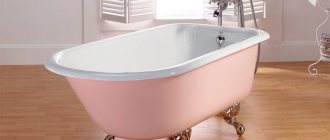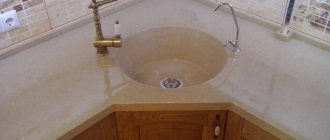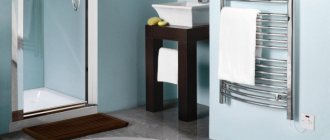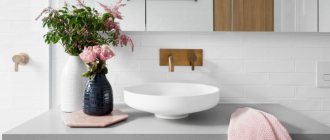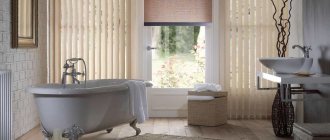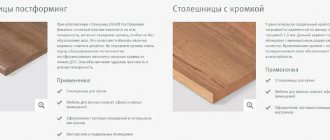A purchase like a bath requires the most careful approach. This is not an item that can be easily changed if something doesn’t fit. High cost, dimensions, the need for installation work - all this implies a purchase for many years. To choose the right bathtub, you need to focus not only on the appearance and size, but also on other characteristics that affect the durability, convenience and practicality of the product.
Which bath to choose
What types of baths are there?
Modern bathtubs are distinguished by a wide variety of shapes, sizes, materials used, and equipment. High demand contributed to the expansion of the range with more advanced designs that provide maximum comfort when bathing. Let's look at the main criteria that influence the choice of bathtub.
Dimensions and shapes
There are standard dimensions for each type of bathtub, but they are not suitable for everyone. Typical dimensions are 80x160 cm with a bowl depth of 50-65 cm, the shape is rectangular. Until now, this design is the most common, although it is gradually giving way to models of other configurations. Plumbing manufacturers produce round, oval, hexagonal, corner bathtubs, differing in depth, capacity and weight. The height of the bowl varies between 40-100 cm, but most often it is 65 cm, according to European standards. The size of the bathtub is selected depending on the size of the people living in the apartment and the parameters of the bathroom itself.
Dimensions of bathtubs. How to make the right choice
type of instalation
According to the type of installation, bathtubs are wall-mounted, free-standing and built-in. The first type is considered the most common, and bathtubs adjacent to the wall are usually square and rectangular in shape. Oval and semicircular models are less common. Many designs are installed on legs and covered from the outside with a decorative panel or screen.
Variety of free-standing bathtubs
Built-in baths
The space between the bowl and the screen is convenient to use for storing household chemicals and individual shower accessories.
Functional bath screen
Using the space under the bathroom to store household chemicals
Wall-mounted structures also include corner structures, which are in demand due to their compact placement. Corner bathtubs are most often triangular, but they are also available in the form of a rhombus, trapezoid, and pentagon. As a rule, they are installed directly on the floor or a special podium, the outer side is covered with a screen or lined with ceramics.
Wall-mounted corner bathtub model
Freestanding bathtubs take up a lot of space and are therefore only suitable for spacious rooms. Models of this type are also quite diverse: oval, rectangular, round, with or without legs, plain and with a pattern. They are considered the most expensive option, as they have decorative finishing on all sides, many designs are supplemented with luxury fittings, and sewer pipes are installed according to a special project.
Freestanding clawfoot bathtub
Bathtub with floor-mounted mixer
Built-in bathtubs are installed in two ways: they are recessed into the floor or mounted on a podium equal in height to the bowl. Design features require certain technical conditions, so this option is more suitable for private homes. To install such a model in a city apartment, you must have permission from the relevant services, which is not always possible to obtain. Built-in structures are very easy to use and look great in the bathroom interior due to the external finishing of the sides.
Built-in bathtub with podium
Finishing a built-in bathtub with mosaics
Built-in baths
Availability of additional accessories
Plumbing manufacturers pay a lot of attention to consumer comfort, so most bathtubs are equipped with additional accessories. The more expensive the model, the more functional its equipment. The most budget-friendly ones include armrests, handles, soft and comfortable headrests. Next comes lighting, water ozonation systems, and temperature sensors. The most comfortable are baths with air and hydromassage systems and a control panel for selecting modes.
Bath with hydro and air massage, headrests, remote control
In addition to the listed criteria, the material of manufacture is of great importance. It is on this basis that the main division of baths by type occurs:
- steel;
- cast iron;
- acrylic;
- quaryl;
- earthenware;
- marble and stone;
- glass;
- wooden;
- copper.
Each material has certain characteristics and has both pros and cons. To choose the ideal option for yourself, you need to study and compare the qualities of all the listed types of bathtubs in more detail.
Glass models
Fans of non-standard solutions will appreciate the glass design. It is an ideal option in terms of aesthetics and practicality, and also has the following features:
- visual increase in space;
- strength and durability;
- unusual appearance;
- safety, environmental friendliness;
- long-term preservation of water temperature.
Unusual glass bathtub.
The main disadvantage is the need for regular maintenance and high cost. Before choosing such a bath, you should think about whether you can keep it clean.
Steel baths
Steel products are in stable demand in the plumbing market. This is due, first of all, to the practicality and availability of the material.
Steel baths - advantages
| Technical specifications | Values |
| Wall thickness | 2.5-4 mm |
| Bowl weight | 30-40 kg |
| Bowl depth | 38-40 cm |
| Bathtub height from floor to sides | 55-75 cm |
| Bath width | 70-85 cm |
| Bath length | 120-180 cm |
Advantages:
- Baths of any configuration can be cast from steel, which allows manufacturers to constantly expand their model range;
- the production of steel products does not require large expenses, so bathtubs made from this material are the most affordable;
- steel has low porosity, and after applying enamel, the material’s resistance to contamination increases significantly. Dirt practically does not eat into the walls, and accumulated plaque can be easily removed using cleaning products;
- due to its light weight, the bathtub does not place excessive load on the subfloor and can be installed in any convenient place;
- With careful use, a metal bathtub will last more than ten years without losing its visual appeal.
Flaws:
- steel has high thermal conductivity, so the water in the bath cools quickly;
- when struck, dents appear on the walls, the enamel cracks and crumbles, which leads to rapid wear of the product;
- When filling the bathtub with water, a loud noise occurs due to the low sound insulation of the material.
Bathtubs made of stainless steel and enameled
Steel bathtub
Installation Features
A steel bathtub with legs is very unstable and, due to its low weight, can easily tip over along with the water and the person in it. To prevent this from happening, such models are installed flush against the wall, and the legs are inserted into special fasteners on the floor and screwed tightly. There is another way - install the bathtub on bricks, and fill the gaps between the sides and the wall with foam.
How to properly place a bathtub on bricks
The brick support will securely fix the bathtub, and the foam will additionally absorb noise from water jets. Rubber pads also help reduce noise, which are recommended to be attached during installation in the places where the supports adjoin the bathtub bowl. But the most effective way of soundproofing is to cover the outside of the bowl with thin sheet rubber or penofol before installing the bathtub in place. To save time, you can simply cover the entire surface with polyurethane foam and let it harden well.
Ways to increase the sound-absorbing capacity of steel bathtubs
Features of installing a steel bath
Installation of a steel bath
Installation of a steel bath. Instructions
Signs of product quality
To ensure that your purchase does not disappoint, you should know the main features of quality bathtubs. For metal models they are as follows:
- optimal wall thickness 3.5 mm;
- the presence of a noise-absorbing coating on the outside of the bottom;
- absence of chips, scratches, microcracks, stains and other defects on the enamel;
- absence of dents, deflections on the walls and sides of the bathtub.
Tips for choosing a steel bathtub
Cast iron baths
The popularity of cast iron bathtubs has decreased markedly with the advent of acrylic and other new materials. And yet, there is a certain demand for such models, and therefore buying them is not a problem. Unlike products of the Soviet period, modern cast iron bathtubs have thinner walls and an aesthetic appearance, making them fit perfectly into any interior.
| Technical specifications | Values |
| Wall thickness | 5 mm |
| Bowl weight | 90-100 kg |
| Bowl depth | 40-65 cm |
| Height from floor to sides | 53-70 cm |
| Bath width | 70-85 cm |
| Bath length | 120-185 cm |
Cast iron baths
Advantages:
- cast iron does not corrode and is not afraid of mechanical stress, and therefore cast iron bathtubs are the most durable of all possible options;
- Due to their heavy weight, cast iron bowls are very stable and reliable. Even if you lean heavily on the side of a free-standing bathtub, it will not tip over;
- cast iron has a high heat capacity, so hot water in the bath does not cool down for a long time;
- The cast iron surface tends to muffle sounds, so the bathtub does not rattle under running water.
Flaws:
- limited choice of forms. Most cast iron models have a rectangular or oval shape and differ only in the size of the bowl;
- large models cannot always be installed in city apartments due to their weight;
- the porosity of the material contributes to the accumulation of contaminants and complicates the cleaning of the surface, even despite the enamel coating.
How much does a cast iron bath weigh?
There are no particular differences in the installation process, the main thing is to make sure the strength of the floors. When calculating the load, you should take into account not only the weight of the bath itself, but also the mass of water at maximum filling, as well as the weight of the person taking the bath.
Cast iron bathtub with legs
Signs of quality
A high-quality cast iron bathtub is very heavy, unlike fakes. If you managed to move it from its place without much effort, you should not buy such a product. Be sure to knock your knuckles on the bathtub in several places. If the sound is the same, the quality is good; if it differs, the composition of the cast iron is not uniform, which means the bathtub will not last long. Sagging and bumps on the enamel layer indicate poor quality of the protective coating, uneven application or violation of processing technology.
One of the types of cast iron baths
Features of choosing cast iron baths
Beautiful cast iron bath
Hydromassage units
A hot tub will not only help you relax as much as possible, but it will also benefit your health by improving blood circulation. Special nozzles are installed on the side walls and bottom of this design, and a motor with a pump is installed under the bathtub.
Hydromassage bath.
Note! Do not use bubble bath, soap or shampoo while the jets are on.
The hydromassage model has many advantages, but requires special care.
The hydromassage bathtub is equipped with great functionality.
Acrylic bathtubs
Acrylic is a synthetic polymer, that is, it is a type of plastic. This material is widely used in plumbing production due to its many positive properties. Acrylic baths are made by blowing a hot mass in special vacuum chambers, after which the products are additionally reinforced with fiberglass or metal mesh. This technology allows you to make bowls of absolutely any shape, so acrylic bathtubs have the widest variety of models.
Shape and dimensions of acrylic bathtubs
| Technical specifications | Values |
| Wall thickness | 5-6 mm |
| Bowl weight | 15-25 kg |
| Bowl depth | 48-65 cm |
| Height from floor to sides | 54-67 cm |
| Width | 70-160 cm |
| Length | 120-180 cm |
The diameter of round products usually varies between 140-200 cm, but can be increased when made to order. There are models designed for bathing in a sitting position, which, with a large capacity, take up minimal space in the room. The dimensions of such bathtubs range from 130x70 cm to 150x110 cm, and the depth of the bowl is 40-80 cm.
Additional functions of acrylic bathtubs
Advantages:
- acrylic is several times superior to cast iron in terms of heat capacity. This means that the water in the bath will cool very slowly, no more than 1-2 degrees every half hour;
- the relatively low weight allows you to install the bath in any convenient place without calculating the load on the floors. In addition, delivery of the product to the apartment and its installation will not require much effort;
- The acrylic surface is very easy to care for - the material is resistant to household detergents and is not affected by fungi;
- The glossy surface does not fade or wear off during use of the bathtub and can be easily restored. To eliminate minor scratches, chips and other defects, there are special kits on sale;
- acrylic is safe for human health.
Flaws:
- the specifics of production determine the very high cost of acrylic bathtubs compared to cast iron and steel;
- Do not pour boiling water into the bath, as high temperatures cause deformation of the material;
- to clean the surface, do not use compositions with solvents that react with acrylic and corrode it;
- Due to the malleability of the material, the walls of the bathtub are easy to scratch. For this reason, you should not use abrasive substances for cleaning, and you should also avoid dropping solid objects into the bowl. Pet owners should try to bathe their pets as carefully as possible, because their sharp claws can also damage the surface.
Acrylic bathtubs
Installation features
Features of the installation include the mandatory presence of a metal frame, which is a frame made of a steel profile with an anti-corrosion coating. In addition to bowl supports in each corner, the frame has additional stiffening ribs and is equipped with height-adjustable legs. The functions of the frame are to optimally distribute the load throughout the bowl and prevent deflections. Very often the frame comes complete with the bathtub, but sometimes you have to buy it separately or make it yourself.
If there is no factory frame, the installation of the bathtub can be done in two ways - install it on bricks, laying out the walls of the appropriate height, or mount a structure made of timber and waterproof plywood. The first method is more labor-intensive and takes more time, the second is much simpler.
| Image | Step by step description |
Step 1 | Take measurements of the bowl and the height from the floor to the sides. Using these measurements, the timber is cut so that 4 blanks for the frame and 8-10 support posts are obtained. The workpieces must be impregnated with a protective composition and dried thoroughly. |
Step 2 | A frame is assembled from the beams, connecting them together with metal corners and screws, and tightly fixing them to the floor and wall |
Step 3 | A sheet of waterproof plywood is stuffed on top of the resulting frame, in which a hole is cut into the bathtub bowl using a jigsaw. If the bowl is not oval, but rectangular in shape, instead of plywood, a strong board is used, which is packed around the perimeter of the frame |
Step 4 | Insert the bathtub and check its horizontal position using a building level. If the sides are at different heights, wooden pads can be attached to the boards under them. Next we connect communications |
Step 5 | The outside of the frame is sheathed with any suitable sheet material or covered with a purchased screen that does not require additional finishing. |
Signs of quality of acrylic models
Acrylic bathtubs are most often counterfeited using ordinary plastic. In addition, many manufacturers do not adhere to established standards and produce acrylic products that do not stand up to criticism. The following signs will help determine quality:
- wall thickness is not less than 4 and not more than 5 mm. A thin bowl will bend at the slightest impact, and a product with a wall thickness of 6 mm may turn out to be plastic, coated with a layer of acrylic;
- bathtubs with complex configurations are usually of lower quality than standard models, due to the peculiarities of production;
- stronger and more reliable than bathtubs with steel reinforcement, since fiberglass cannot provide such strength;
- When tapped, a high-quality bathtub will make dull sounds, while a fake one will make ringing sounds.
Imported or domestic acrylic bathtubs
Comparison results
In terms of the total points scored, steel bathtubs are in the lead by a significant margin - 89 points. Cast iron bowls scored 81 points, acrylic bowls - 80.
However, there is an important point here: when choosing a not very expensive product, consumers pay attention to the weight, functionality, variety of shapes and sizes of bowls. Steel plumbing has all this. But here, too, there is a clear bias in buyer preferences in favor of stainless steel, which indicates, firstly, that the practicality of the product fades into the background, and secondly, the durability of stainless steel, together with an acceptable price, outweighs all other criteria.
Quaril bath
In an effort to improve the characteristics of acrylic, experts created a new material - quaril. This is a combination of quartz sand and acrylic, which has increased strength. Bathtubs and shower trays are mainly made from quaril, casting them in special molds. Due to the hardness of the material, quaril baths can be used both with and without a frame, which significantly expands the product range. The main parameters of bathtubs are the same as those of acrylic ones, only the wall thickness (9-10 mm) and weight (30-40 kg) differ. The range of models is very wide, there are products with both streamlined and strict geometric shapes.
Quaril bath
Advantages:
- the possibility of the bowl bending is excluded even with active influence on its walls;
- very aesthetic appearance, which is maintained throughout the entire service life, due to its resistance to abrasion and minor damage;
- convenience and ease of installation;
- hygiene of the material. The surface of the quarry is very smooth and dense, so any dirt is easily washed off with clean water. If plaque appears on the walls, it can be easily removed with any detergent;
- the heat capacity of the material is as high as that of acrylic;
- despite the smoothness, the surface of the bowl is absolutely non-slip;
- The material perfectly absorbs sound, making the filling of the bath almost silent.
Rectangular bathtub made of quaril
Quaril bath
Flaws:
- the prices for such bathtubs are much higher than for acrylic ones, and therefore not everyone can afford them;
- Quarilic products are lighter than cast iron, but noticeably heavier than acrylic bathtubs. When purchasing a large model, you need to take into account the condition of the interfloor ceilings;
- Quaril should not be exposed to high temperatures due to the presence of polymers in the composition. If boiling water is poured into the bathtub, the bottom and walls may become deformed in places.
Quaril is a new material, and few can recognize it by its external signs. This is taken advantage of by unscrupulous manufacturers who, under the guise of quaril baths, sell products made from cheap materials with a masking glossy coating. In order not to buy such a product, you should choose a quaril bath exclusively in specialized salons with a proven reputation. Products must be certified, with a guarantee of quality, of foreign production. Domestic brands, unfortunately, have not yet sufficiently mastered this technology.
Quaril baths: features
Instructions on how to choose the right bathroom
- It is advisable that the bathroom be the most accessible. People often enter it, so it is best to place it near the exit/entrance.
- The ideal option is a separate room for the toilet. But if you do not have such an opportunity, then try to create a small fence for the toilet yourself and separate the rooms.
- To furnish your bathroom, choose materials that are not afraid of water.
- Don't buy wallpaper.
Recommendations for selection
Having decided on the choice of bathtub material, you should choose the right shape and dimensions to ensure maximum comfort for everyone living in the apartment. First of all, the length of the bowl should correspond to the height of the tallest member of the family. To determine the optimal width of the bowl, you need to add 10-12 cm to the shoulder width. That is, when a person lies in the bath, there should be at least 5 cm of free space between the body and the walls. Of course, the size of the person with the largest build is taken into account, not height.
The most comfortable height of the bathtub from the floor to the sides is 60-70 cm. If there are children in the family, choose the minimum height, otherwise it will be difficult for the child to get into the bathtub. In the absence of models of the required height, it will be possible to install steps or mount a podium especially for children. The second option will cost more, but it will be more convenient to use the bathroom.
One of the most important factors when choosing a bath is the characteristics of the room. The dimensions of the room, the reliability of the floor coverings, the location of sewer pipes and plumbing fixtures - all this must be taken into account before the purchase, and not after it. It is best to make a schematic sketch on paper, indicating the location of plumbing fixtures and furnishings. This will help model the most convenient option and simplify the choice. Be sure to measure the width and length of the bathroom, the width of the doorway, and indicate on the diagram the expected passage between the bathroom and the wall. Not everyone can independently assess the condition of the ceilings in an apartment, so if the choice fell on heavy models, you need to invite a specialist. This is especially true for those who live in old high-rise buildings.
When you have decided on the dimensions and installation method, the best part is to choose a model based on its appearance and equipment. The style of your bathroom and your personal ideas about comfort play a role here. Study shower drains and drains for showers at the link.
Video - Choosing a bath
Video - Selecting and installing a steel bath
Choosing a manufacturer and prices
To choose a bathtub wisely, you should learn more about Russian and foreign companies that have established themselves as reliable manufacturers of plumbing fixtures.
- Manufacturers of cast iron bathtubs: Universal (Russia), Jacob Delafon (France), Roca (Spain), Goldman (China).
- Companies producing high-quality steel baths: Lipetsk Pipe Plant (Russia), Bette and Kaldewei (Germany), Estap (Slovakia).
- When buying an acrylic bathtub, it is recommended to choose one of these companies: Aquanet (Russia), Pool Spa (Spain), Ravak (Czech Republic), Cersanit (Poland).
- Quaril products are manufactured by the German company Villeroy & Boch.
- When ordering a ceramic bowl, you should give preference to TM Colombo and Santek (Russia), Globo and Flaminia (Italy).
Cast iron bathtubs, compared to other popular models, are more durable and therefore more expensive. The cheapest models are made from steel. An intermediate option is acrylic.
Usually a bathtub is chosen to last for many years and is used every day, so you should purchase a tank that has optimal characteristics and meets the needs of all family members. Choosing a high-quality design is not easy, but a correctly selected product will not only fit perfectly into the room, but will also become one of the most pleasant places in the house.

